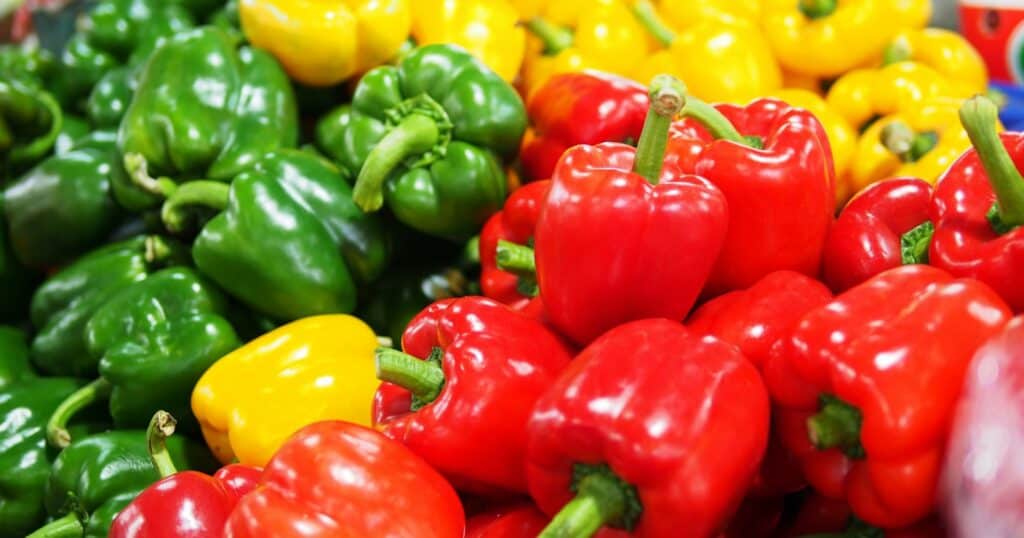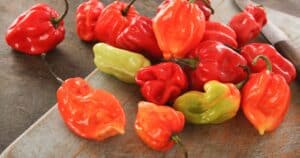Have you ever stood pondering in the produce section, trying to decipher the distinction between bell peppers and sweet peppers? If so, you’re not alone! Many home cooks find themselves scratching their heads over whether these colorful capsicum cousins differ.
Bell Peppers and Sweet Peppers Are One and the Same
Here’s the inside scoop that will settle the pepper puzzle once and for all: bell peppers and sweet peppers are scientifically identical. There are absolutely no botanical discrepancies between the two.
Bell peppers simply refer to the most widely available variety of sweet pepper. You’ll spot them in green, red, orange, yellow, purple, and even chocolate hues. Meanwhile, the category of “sweet peppers” encompasses all peppers of the Capsicum annum species that lack
Now that we’ve cracked the case on whether bell and sweet peppers differ, let’s explore…
How Pepper Color Impacts Flavor

While bell peppers and sweet peppers are essentially the same veggie, their shade signifies distinct flavors:
Green Bell Peppers
- Sport the least sugar of the bunch, with subtle bitter notes
- Offer a pleasing snap and vegetal flavor
- The seeds bring a slight bitterness, but can be eaten
Red Bell Peppers
- The sweetest of the bell varieties, with fruity undertones
- Hints of berry, cherry, and citrus shine through
- Perfect balance of sugary and savory
Yellow and Orange Bell Peppers
- Not as sweet as red bells, but still delectable
- Milder and less citrusy flavor than their crimson cousins
- Low bitterness makes them crowd-pleasers
Other Colorful Bell Peppers
- Purple, chocolate, and striped bells also exist!
- Similar flavors to their relations, with unique appearances
- Expand your palate with their undertones of smoke and earth
The Maturation Process Creates Color Changes
Ever notice green bell peppers eventually turn red? There’s a reason behind their chameleonic abilities.
As bell peppers mature on the vine, their chlorophyll breaks down and reveals the colorful carotenoids beneath their skin. They transform in stages:
- Green (unripe) → Yellow → Orange → Red (fully ripe)
Therefore, freshly picked green peppers will sweeten up if left to ripen. Patience pays off in sugary satisfaction!
Tasty Ways to Bring Bell Peppers to the Table
Now that you’re a bell pepper expert, it’s time to enjoy these crisp, vibrant veggies in your cooking!
Raw
Raw bell peppers lend crunch and freshness to dishes like:
- Salad and salsa
- Crudités with dip
- Wraps and sandwiches
- Vegetable trays
- Snacking
Tip: Pair raw green peppers with foods containing acidic ingredients like citrus, vinegar, or yogurt. The acidity balances out the slight bitterness.
Sautéed
Cooking bell peppers coaxes out their natural sugars. Sauté and add them to:
- Fajitas and stir fries
- Omelets
- Pasta dishes
- Pizza
- Quiche
- Filled with rice
Roasted
Roasting bell peppers caramelizes their skins and concentrates the flavor. Chop up roasted peppers for:
- Soups, stews, and chilis
- Sandwiches
- Tacos
- Flatbreads
- Antipasto
- Casseroles
- Sauces
Grilled
Like roasting, grilling boosts peppers’ sweet qualities. Grill them to bring out their essence for:
- Kabobs
- Fajitas
- Panini
- Burritos
- Quesadillas
- Veggie burgers
- Pizzas
Stuffed
With their hollow cavities, bell peppers are the perfect vessels for stuffed veggies! Stuff them with:
- Rice, quinoa, or couscous
- Ground meat
- Beans
- Cheese
- Vegetables
- Herbs
Get creative and whip up inventive fillings!
Pickled
Pickling preserves peppers while infusing them with tangy flavor. It also tempers any residual bitterness in green bell peppers. Enjoy pickled peppers as:
- Condiments
- Sandwich and burger toppers
- Additions to salads, slaws, and relishes
- Antipasto components
- Martini garnishes
Tips for Selecting and Storing Bell Peppers
Follow these guidelines to pick and store bell peppers for maximum freshness:
- At the store: Choose peppers that feel rigid, smooth, and heavy for their size. Avoid ones with wrinkles, soft spots, or blemishes.
- At home: Place unwashed peppers in a plastic bag in the fridge. They’ll keep for up to 1 week.
- For maximum shelf life: Store unwashed peppers unrefrigerated in a cool, dry spot. They’ll last 2 weeks or longer.
- To freeze: Slice or dice peppers, spread on a baking sheet, and freeze. Transfer to airtight bags once frozen. They’ll keep for up to 10 months.
Bell Peppers Pack a Powerhouse of Nutrition
Beyond being scrumptious, bell peppers deliver impressive health perks, like:
- Vitamins A and C: Rich in antioxidants and immunity boosters. A single pepper has over 300% of your daily vitamin C needs!
- Fiber: Helps regulate digestion and promotes satiation.
- Potassium: Regulates blood pressure.
- Anti-inflammatory benefits: From vitamins C and E. May ease arthritis discomfort.
- Eye health support: Vitamins A and C nurture vision and prevent macular degeneration.
- Folate: Essential for red blood cell production and heart health.
- Phytochemicals: Compounds that may inhibit cancer cell growth.
So savoring bell peppers not only delights your palate—it benefits your whole body!
The Final Takeaway on Bell Peppers and Sweet Peppers
Hopefully this guide has resolved any remaining confusion about bell peppers versus sweet peppers. The main points to remember are:
- Bell peppers and sweet peppers are the same species scientifically.
- Bell peppers simply refer to the common varieties in hues like green, red, yellow, and orange.
- Their color determines the flavor, from bitter green to sweet red.
- Allowing bell peppers to ripen on the vine transforms them from green to red.
- Enjoy bell peppers raw, cooked, stuffed, or pickled for a boost of nutrition and intrigue.
The next time bell versus sweet peppers pops up, you can dazzle with your produce knowledge. Now that you’re an expert on selecting, savoring, and storing these crisp gems, it’s time to pepper your dishes with their vibrant colors and flavors!





